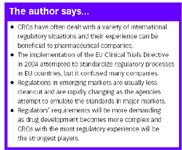Regulatory affairs: additional value?
Pharmaceutical Technology Europe
All commercial sponsors want to maximize their profit and, with a population close to 500 million, the EU is an enormous potential marketplace that they simply cannot ignore!
Initially, pharmaceutical companies only handed select portions of clinical trial work to CROs and the arrangement was always characterized by a degree of 'fear of losing control' over the project. With time, this has changed, and CROs are now much more involved in the clinical trial process and expected to provide strategic input. The Tufts Center for the Study of Drug Development reported that in 2004, CROs managed 23000 Phase I–IV clinical trials worldwide, monitored more than 150000 clinical investigators and enrolled more than 640000 new subjects.1 The study also revealed that projects involving high CRO usage stuck closer to timelines as such projects were submitted more than 30 days closer to their projected submission date.

Faiz Kermani
In recognition of these trends, many CROs have expanded the number of services they offer. This has seen them move past simply helping with day-to-day operational tasks, and major CROs can now handle almost any aspect of the trial process and related activities.
Regulatory affairs
One area of drug development that pharmaceutical companies often struggle with is the regulatory stage. This final phase of drug development is the last hurdle before a drug reaches the market and is beyond the control of companies. There are often problems as the process involves an external regulatory agency that reviews the data in an independent fashion. As regulatory agencies are government bodies, and thus accountable to the public, public safety is paramount and their decision-making must be geared towards this factor rather than a company's hopes and expectations.
CROs are in a powerful position to demonstrate their expertise. As they work on different projects, many have dealt with a range of international regulatory scenarios and are at an advantage as regulatory affairs departments in many pharmaceutical companies have often not been exposed to the same level of variation.

The author says...
The outcomes of regulatory reviews cannot be predicted, but companies can be better prepared by planning ahead and seeking good advice on regulatory options and guideline changes. If a sponsor is using the services of a CRO that has a regulatory affairs department, it would be wise for the sponsor to consider asking their opinion. As CRO regulatory affairs personnel frequently deal with regulatory agencies, they often build up a more realistic picture of what is expected, whereas a sponsor can be overly biased because of expectations for a specific product. In addition, CRO regulatory personnel tend to work concurrently with numerous agencies in different global regions across various projects, whereas the sponsor is often limited to national markets for a set number of products. This allows CROs greater insight into the nuances of decision-making within regulatory agencies. Companies accustomed to dealing with a particular regulatory agency can find that changing countries dramatically alters the regulatory strategy and the time involved in gaining approval for a trial.
As the pharmaceutical industry operates on an international basis, it is crucial to understand the manner in which international regulatory guidelines are changing. There is also a great deal of cross-talk between regulatory agencies, which should not be underestimated. Regulatory questions that arise with an agency on one side of the world may appear elsewhere. To provide value to sponsors, CROs have had to become experts in international guidelines so that they can provide advice at the outset of a trial.
European changes
An example of how CROs can provide value occurred in May 2004 with the implementation of the European Clinical Trials Directive and its associated legislation. Prior to this date, there had been diverse processes of initiating and conducting clinical trials among Member States, as well as Iceland, Liechtenstein, Norway and other members of the European Economic Area where the Directive is also binding. Many sponsors had become accustomed to the pre-directive era and were frustrated by the impending changes. For CROs, there was no choice but to become as familiar with the new procedures as quickly as possible to advise potential clients.2
Although it may not have appeared so initially, one of the primary aims of the directive was to unify the regulatory processes in different Member States. Until this point, a situation had existed whereby certain countries had a distinct advantage over others in attracting clinical trials to their territory. Many sponsors favoured certain countries for trials and found the changes disruptive to their plans.
The changes were also complicated by the continuing expansion of the EU, leaving many sponsors confused about the implications for trials they wished to run in newer Member States. Also, as the regulatory changes manifested themselves in the form of a 'directive', additional steps were required for the principles to be incorporated into national laws, and CROs had to determine how these changes would be implemented in the different Member States and in what timeframe. This was difficult as the outcome depended on legislative processes. Despite the widespread media coverage of its implementation, some EU countries had not implemented or had only partially implemented the directive's provisions 6 months after the deadline. During the transition, companies found the processes unclear, but many CROs expected there would be advantages regarding standardized processes as countries defined their national legislation.
US-based sponsors were particularly troubled by the implications of the directive. In light of the new requirements, some asked why they would want to incur the expense and disruption of conducting clinical trials in Europe when they could be performed in the US. As a strategic partner, it was important for the CRO to remind them of the long-term view and the end-result of their clinical trials — a marketing authorization application. All commercial sponsors want to maximize their profit and, with a population close to 500 million, the EU is an enormous potential marketplace that they simply cannot ignore!
Emerging markets
Pharmaceutical companies are conducting a growing number of clinical trials in emerging markets. The major drug development regions of the world remain North America, Europe and Japan, but markets such as those in Asia, Latin America and Africa have emerged as important locations for clinical trials. Costs in emerging regions are frequently perceived as less than in the main pharmaceutical markets because of fast patient recruitment and lower operating costs. Furthermore, these regions often feature a sizeable group of patients with the therapeutic conditions that pharmaceutical companies are interested in, and there is growing competition between companies to recruit patients for their trials in these regions.
The trend in using emerging regions has further significance as they are also becoming important markets for new medicines. Through clinical trials, local physicians gain experience of new products and, therefore, it is in a company's interests to base some clinical research in these locations. In some countries, regulators expect some local clinical development of a product to have been conducted.
This has allowed CROs to demonstrate their value through the provision of regulatory advice. In more established markets, the regulatory, ethical and clinical research environments are fairly well-defined, and so companies have sufficient previous experience to help them adapt to further changes. However, with emerging regions of the world environments are less clear-cut and guidelines that are acceptable elsewhere may not necessarily apply. Furthermore, many of the regulations in these countries are rapidly changing as agencies attempt to match the standards expected in major markets to attract clinical trials to their territory.
Many CROs saw the value of emerging markets early and this practical experience has proved invaluable in aiding sponsors to get the best out of these markets. For example, in India the regulatory environment is being advanced through the revision of Schedule Y.3 Schedule Y deals with regulations relating to clinical trial requirements for import, manufacture and obtaining marketing approval for a new drug in India. The procedure for applying for marketing approval depends on the status of the new drug. Many sponsors need advice on what these revisions mean to take advantage of improvements in market conditions to run trials.
Outlook
Sponsors are becoming more reliant on CROs for their clinical trial projects and one of the major growth areas for CROs to provide value to their clients is through regulatory affairs. As drug development becomes more complex, so too will the requirements specified by regulators. CROs that are able to demonstrate knowledge in this field will be in a powerful position. Furthermore, the more international their regulatory experience, the stronger their position will be in bidding for the largest clinical trial programmes.?PTE
References
1. January/February 2006 Tufts CSDD Impact Report, Association of Clinical Research Organizations. www.acrohealth.org/tufts.php
2. UK Corporate Solutions, "Chiltern announces EU Directive seminar dates" (2004).www.ukcorporatesolutions.com
3. U. Sahoo and F. Kermani, "The Contract Research Industry in India" in E.S. Langer (Ed.), Advances in Biopharmaceutical Technology in India (BioPlan Associates, Inc., Rockville, Maryland, USA, 2007) pp 281–312.

Drug Solutions Podcast: A Closer Look at mRNA in Oncology and Vaccines
April 30th 2024In this episode fo the Drug Solutions Podcast, etherna’s vice-president of Technology and Innovation, Stefaan De Koker, discusses the merits and challenges of using mRNA as the foundation for therapeutics in oncology as well as for vaccines.
Drug Solutions Podcast: Applying Appropriate Analytics to Drug Development
March 26th 2024In this episode of the Drug Solutions Podcast, Jan Bekker, Vice President of Business Development, Commercial and Technical Operations at BioCina, discusses the latest analytical tools and their applications in the drug development market.